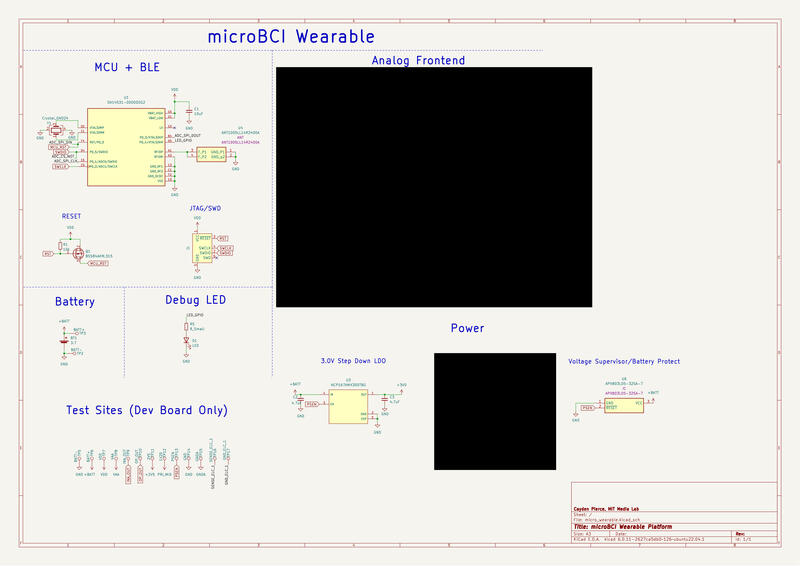Week 5
Design a Circuit
MicroBCI

Intro
I am working on a BCI device that is small enough to fit on one's head as a sticker that hides under the hair.
This is motivated by a major problem of brain sensing - the physical and social comfort issues of wearing a large, uncomfortable, visually obvious headset isn't realistic in day-to-day life.
I have a lot of experience in KiCad, so I decided to use that for the design of the system.
Requirements
First, the biggest/major concern is that everything must be crazy small. I want the final design to eventually be a board that is 5x5mm, so that means that no component can be much larger than 2x2mm or so.
Also, the system must be very low power so as to make the battery as small as possible.
This is a WIP project that is going to be turned into a paper, so not all of the schematic and info can be shared. However, I can share my work progress.
Picking Parts
MCU: must be very small, low power, and capable of Bluetooth for wireless transmission
Analog: ussually, one might use a highly integrated chip that does all of the analog processing and just output the digital signal to the MCU. Howevever, after doing a lot of searching, all of the highly integrated electrophysiology ICs are like 5x5mm or bigger, so I had to go smaller. Thus I decided to design an analog design using an INA and Opamp.
Power: I need a super super small battery that has a reasonable capacity. At first I looked at stuff like these 1.5V cell batteries, but their current capacity is in the microamps, and I need milliamps, so I ended up finding the worlds smallest LiPo 3.7V button cell battery (see render below).
Antenna: So antennas are weird because they are spatially related to the wavelength/frequency of the signal they are TX/RX'ing. We need to find the smallest possible 2.4Ghz antenna possible. The ANT1005 is the best here.
Analog
Sampling frequency >= 256Hz
Bit depth >= 16bit
EEG signal 1-150uV
ADC input is 0 to 2.5V, so we need 10,000x to 20,000x gain.
Most INA's and op-amps that are small are 1,000x or smaller gain, so we must chain 2.
Schematic
The schematic needs to remain mostly closed source for now, but it is completely designed in Kicad.

Dev Board
So using BGA and stuff is great, but I need to debug the system, and everything at 0201 and BGA is not gonna be easy to do that. SO I made all the parts big and put them in a dev board. Here's the render from KiCad:

Hardware/Electrical Render
I exported the PCB from KiCad and opened it in Fusion. I also imported the electrode into Fusion. Then I found a button cell 3D model and scaled it to be the size of my battery. Then I made a small case and used Fusion360 to animate the system: